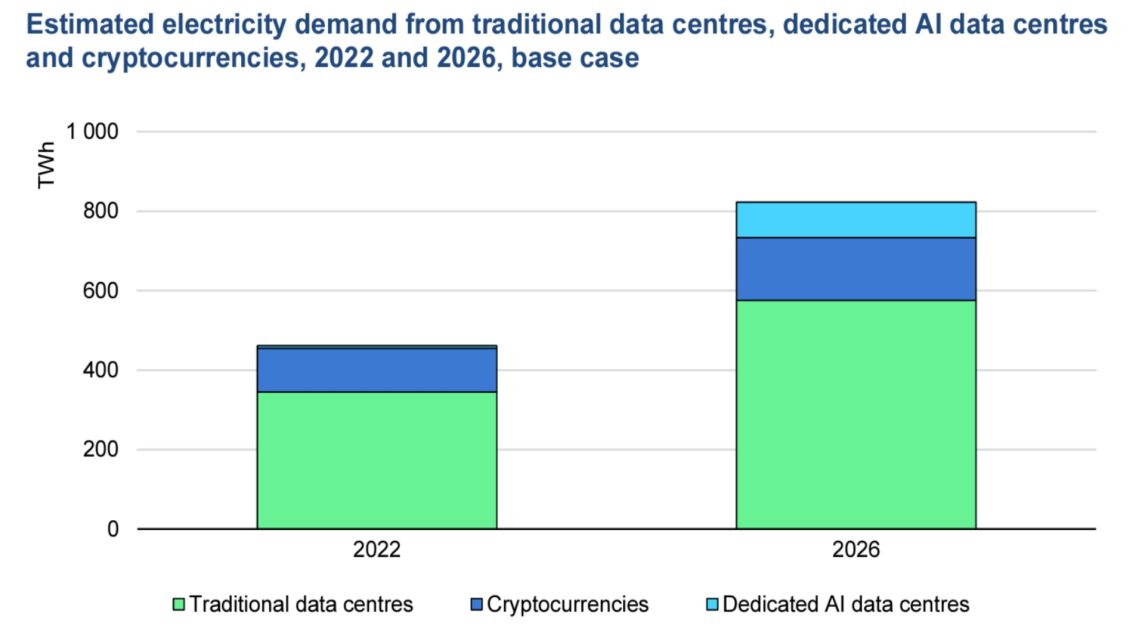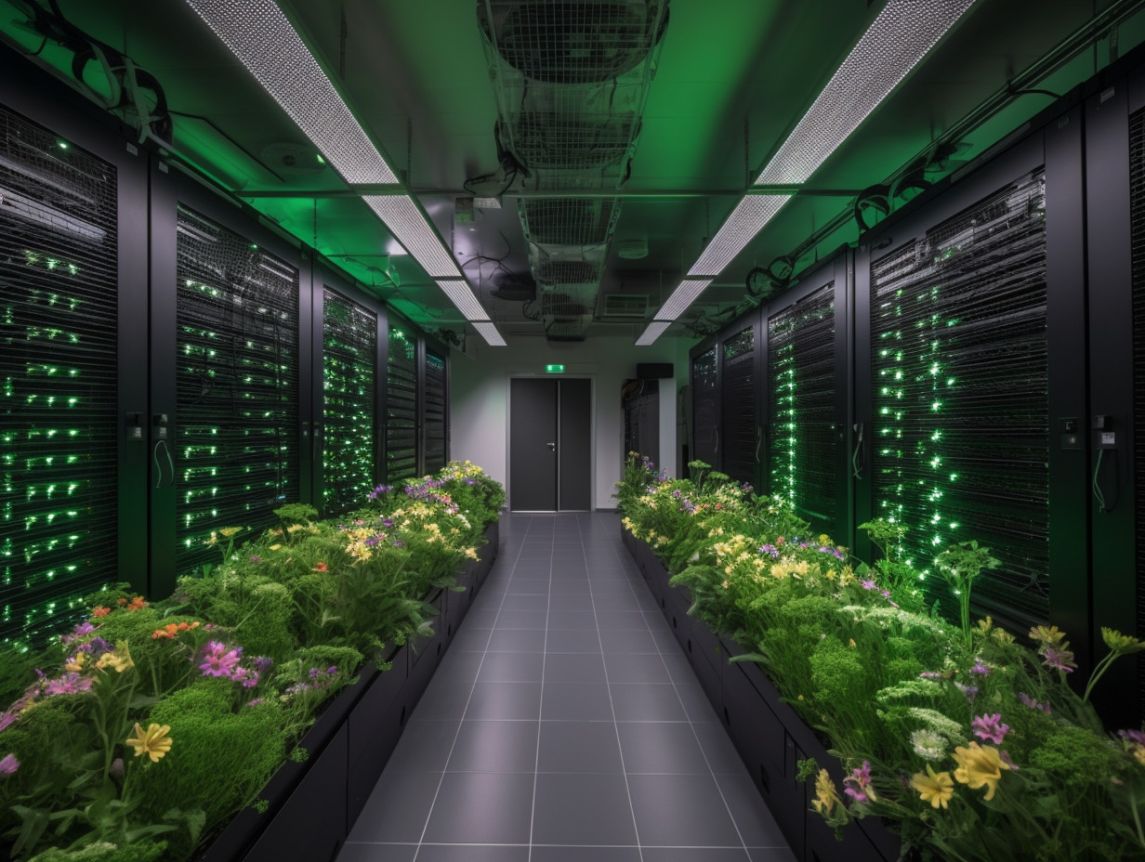In times of increasing digitalisation and the transformation to an AI-driven society, Green-IT can help to meet climate targets and is becoming a critical competitive factor for companies.
The global energy demand for data centres is between 200 and 1,000 terawatt hours (TWh) per year, depending on the source. To put this into comparison, around 500 TWh were generated in Germany in 2020. And according to forecasts, the energy consumption of data centres will continue to rise. Based on figures from the International Energy Agency (IEA), electricity consumption by data centres worldwide could grow from just under 500 TWh in 2022 to over 800 TWh in 2026.

A considerable part of the increase is due to the growing use of AI applications. ChatGPT, AI in science and as tools for the production of text, images, audio and video are causing AI applications to account for a growing share of total IT energy consumption and are increasing it as a whole. Many experts believe that the digitalisation and use of new technologies, such as generative artificial intelligence, could lead to a rise in the IT sector’s share of total emissions to 8-12% by 2025.
In 2020, the information and communication technology (ICT) sector in Germany alone caused energy consumption of 58.4 terawatt hours, resulting in emissions of 24 million tonnes of CO2 – this corresponds to around 3.7% of Germany’s total emissions.
You can find a very good illustration of how much impact AI training models have on the environment in this calculator.
What is Green IT?
Green IT refers to the environmentally friendly use of IT infrastructures and ICT systems, including hardware and software solutions, taking into account the entire life cycle from production and operation through to disposal and recycling of the equipment.
Why Green IT?
Green IT is a movement that aims to mitigate a number of negative impacts caused by the accelerated digitalisation and rapid growth of the IT industry. Here are some reasons why Green IT is becoming increasingly important:
- Increasing environmental impact: The IT industry generates significant amounts of greenhouse gas emissions, mainly through the energy consumption of data centres and the production of hardware. By using Green IT, these emissions can be reduced and global warming can be further neutralised.
- Costs: Digitalisation and new technologies, especially AI applications, are leading to rising costs. This can be avoided by reducing energy consumption and extending the service life of IT hardware.
- Compliance and regulation: Many countries and industries have introduced regulations and guidelines to reduce CO2 emissions and waste. Compliance with these regulations can be facilitated through the use of Green IT solutions
- Social responsibility and reputation: More and more companies are recognising that they have a social responsibility to be more environmentally friendly. By implementing Green IT practices, companies can reduce their environmental impact, improve their public reputation and strengthen their market position. Green Marketing plays an important role here.
- Opportunities for innovation and possible competitive advantages: The use of Green IT can also open up new business opportunities and offer a competitive advantage as companies develop more efficient and sustainable technologies and processes.
To sum it up, Green IT solutions not only contribute to environmental sustainability, but also offer benefits in terms of cost efficiency, compliance, reputational aspects and innovation. It is therefore a strategic approach that offers both environmental and economic benefits.
However, it is also clear that people’s consumption of resources, and this includes IT, must be reduced in order to enable future generations to have a life on our planet.
The Goals of Green IT
Green IT focuses on the following specific goals:
- Increasing energy efficiency: Minimising the energy consumption of computers, servers, storage and cooling systems as well as other components. This also includes energy-saving management in operating systems and applications.
- Saving resources: Minimising the consumption of material resources – whether by increasing the service life of hardware, improving the utilisation of servers through virtualisation or reducing waste through recycling, fewer paper printouts and better disposal methods.
- CO2 reduction: IT systems contribute to global CO2 pollution through their energy consumption and through manufacturing and disposal processes. Green IT initiatives aim to reduce this contribution, e.g. by using renewable energy in data centres.
- Sustainable procurement and waste management: Selecting suppliers and products based on sustainability principles is another aspect of Green IT. This can also include the purchase of energy-saving and recyclable devices, products with a long lifespan or refurbished devices.
- Reducing emissions and lowering resource consumption in other areas with the help of IT
- Respecting social and ethical aspects when creating IT products or services.
In addition to environmental and climate goals, Green IT also pursues social and ethical goals.
Your maintenance specialists for Green IT
Implementing Green IT in a company
There are many ways in which companies can save resources when using IT and follow a green IT approach. This applies to these areas in particular:
- Employees’ workstations
- Business processes
- Data centres
Green IT in the workplace
Hardly any workplace today can do without IT: Laptops, monitors, smartphones and tablets are not only useful tools, they also consume a lot of energy. It is therefore important to follow a few basic principles:
Pay attention to sustainability and longer life cycles: The production of hardware consumes a lot of resources. If devices such as laptops are used over a longer period of time, this can make a major contribution to sustainability. Just one additional year of use has a major impact. For example, employees’ laptops could be replaced after four, five or even six years instead of three. In order to still have sufficient performance reserves, correspondingly more powerful devices should be purchased. Overall, the costs for the company are usually lower with such an approach than with less expensive hardware that is replaced more frequently.
Use standby mode and shut down devices: If laptops and screens are not used for a short period of time – for example during lunch breaks – they should automatically switch to standby mode. To do this, the central office IT department should configure the energy-saving settings in the PCs’ operating system accordingly. Employees should also be encouraged to shut down or switch off their devices completely after work.
Organisational processes and Green IT
The resource consumption of IT is also determined by the operational processes used in the company. Here are a few examples:
Paperless office: Companies that consistently eliminate paper printouts and model all processes digitally can save valuable resources and protect the environment. Additional cost savings can be realised by using fewer printers and saving on toner.
Only have the meetings that are really necessary: Virtual meetings in the form of video conferences also consume resources and as well as valuable time. Unnecessary meetings should be avoided not only to maximise productivity, but also to increase the efficiency of IT resources. Instead of jour fixes, for example, meetings can only be scheduled when necessary.
E-mail traffic: Every e-mail sent and received requires energy, not to mention its storage. The number of e-mails and the group of recipients should therefore be selected according to efficiency criteria. Unimportant emails should be deleted to free up valuable storage space. One way of doing this is to limit the amount of e-mail storage space per employee.
Green IT: Which possibilities do data centres present?
Data centres are among the largest consumers of energy and resources in the IT industry and therefore provide a wide range of opportunities for the use of Green IT methods:
- Efficient cooling systems: Cooling systems in data centres generally consume more energy than the server or storage hardware installed in them. Energy consumption can be reduced by using alternative cooling technologies such as free cooling, liquid cooling or heat recovery.
- Renewable energies: The easiest way to reduce the CO2 footprint in data centres is to use renewable energies. Either through direct generation (e.g. solar or wind energy systems) or by purchasing green electricity.
- Using the right hardware: Using the latest and most efficient IT infrastructure seems to make sense as it consumes less electricity. However, you should bear in mind that the production of these servers consumes a lot of resources and generates large amounts of emissions. You therefore need to carefully consider how long you want to use the hardware in data centres in order to find a balance between energy savings and emissions generated in the production phase. In most cases, it is worth running the hardware for longer.
- Server virtualisation: Virtualisation allows several virtual machines to be operated on a single physical server. This increases server utilisation and hardware efficiency, which in turn reduces energy consumption.
- Recycling and reuse: Old equipment can be recycled or reused to minimise resource usage and reduces waste.
By implementing these measures, data centres can significantly reduce their environmental footprint while improving their operational efficiency.
Your Green IT support and maintenance professional
Can I meet Green IT requirements with cloud computing and thin clients?
Yes, cloud computing and thin clients can help reduce local energy consumption and help to meet Green IT requirements.
- Cloud computing: A cloud service can help reduce energy consumption by centralising the allocation of IT resources and reducing the need for local data centres.
- Thin clients: Thin clients are small, power-efficient computers that access the computing resources of a central server via a network connection. As a result, thin clients can significantly reduce energy consumption and waste compared to conventional desktop computers.
By combining cloud computing and thin clients, companies can reduce their carbon footprint, lower energy costs and improve their overall environmental impact.
Challenges with the implementation of Green IT
Based on studies by various organisations and interest groups, the difficulties in implementing Green IT can be divided into the following categories:
- Lack of expertise: Most medium-sized companies, but also very large corporations, do not know where or how to start. The breakdown by workplaces, processes and data centres can help here.
- Unclear regulation: The regulations for energy efficiency and environmental impact can vary from country to country, which makes the implementation of Green IT complicated, especially for international companies. A good example is the ‘Corporate Sustainability Reporting Directive’ (CSRD), which has been in place in the EU since 2023, but for which there is no suitable counterpart in the USA.
- Difficult technical implementation: The complexity of software-driven Green IT projects in particular, such as the use of power management software or the implementation of more efficient programming guidelines, can be very high.
- Unclear about the economic benefits: Although Green IT saves costs in the long term, the initial investment can be significant. Companies must therefore justify their short-term hardware, software or process investments with long-term profits or cost savings. However, as the Green IT movement is still very young, many results have not yet reached the mainstream. For this reason, the perception that green IT only costs money still persists among many IT decision-makers.
- Cultural and organisational hurdles: Switching to Green IT often requires a cultural change within an organisation. Employees and managers must recognise the value of sustainability and be prepared to change their working practices.
- Greenwashing: You could say that greenwashing has done about as much lasting damage to Green IT as the doping scandals of the Tour de France. Some large companies have only advertised Green IT practices to improve their image and sell more products. A good example is the company HPE. There is no doubt that, as a hardware manufacturer, it is intrinsically motivated to work on more efficient hardware in every generation, and thus makes a contribution. But the press celebrates HPE as the world champion of sustainability, even though HPE demonstrably does everything in its power to ensure that its products do not run longer than they are intended to. By restricting firmware updates, HPE encourages and enforces the replacement of its servers every 3-5 years, although in most cases the hardware would be capable to run for at least 7 to 10 years without these practices.
Which criteria should a company use as a guide when purchasing hardware and software?
Green IT is a very broad term and therefore difficult to summarise. We have therefore listed a few criteria that you can use as a reference when purchasing hardware and software:
- Energy efficiency: The energy efficiency of devices is an important indicator of their environmental friendliness. Look out for energy labels or certifications such as the EU Energy Consumption Labelling, which provides information on how much power a device such as a monitor is consuming.
- Durability and maintainability: A device that has a long service life and is easy to repair can consume fewer resources over its lifetime than a device that needs to be replaced over the short term.
- Availability of updates: Many manufacturers try to force the replacement of older devices and the purchase of new hardware by no longer offering software updates for older devices after a certain period of time. It is best to find out how long updates will be available for your chosen device before you buy it.
- Recycling and waste management systems: When buying Green IT products, make sure you find out whether there is a programme for returning and properly recycling or disposing of the product at the end of its service life.
- Raw materials and manufacturing process: Find out which materials are used in the production of the device and how environmentally friendly the manufacturing process is.
- Certifications and standards: There are a number of environmental standards and certifications that indicate that a product fulfils certain criteria in terms of sustainability. These include certifications such as Energy Star (mostly USA), EPEAT and TCO Certified
Green IT at Hardwarewartung 24
At Hardwarewartung 24, we consistently follow the Green IT approach and combine sustainability with cost savings for our customers. As an IT service provider, we achieve this primarily through two methods:
- Extending the service life of hardware in the data centre
- Reducing maintenance costs

 Skip to content
Skip to content



